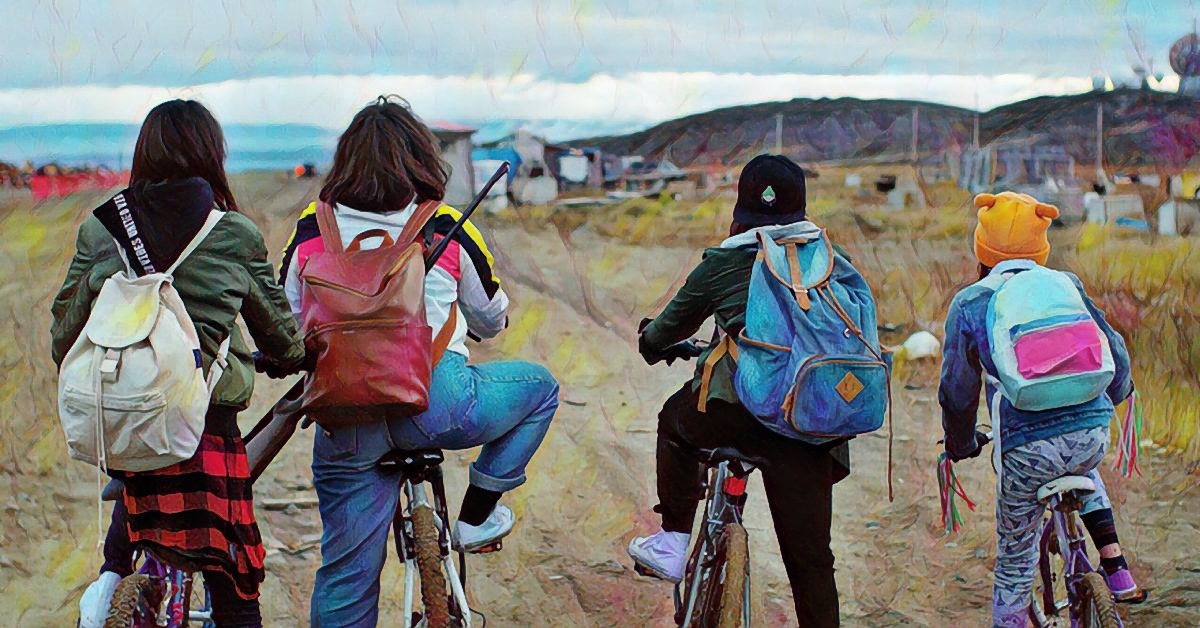
Every society tells stories; this is the way people make sense of the world around them. Cinema has the ability to animate these stories on screen, using a multiplicity of tools, stitching together and presenting these tales visually, resulting in a richly layered, multi-sensory experience. Whose stories are deemed valuable enough to tell and who should be telling them is part of a conversation currently surrounding on-screen representation.
Most would agree that Indigenous narratives from around the globe are both underrepresented and ripe for cinematic interpretation and there are currently many examples of Indigenous directors bringing their own culture’s tales to a wider audience. How can this be achieved however, when these stories are often part of a wholly oral tradition, where the tales are passed on from generation to generation via the spoken word and not a visual medium? How can a story, crafted to excite the imagination with carefully chosen words and phrases, repetition, and verbal metaphor be interpreted visually without losing its ability to educate, inform, mystify or entertain?
Recently, indigenous filmmakers and collectives around the world have successfully adapted stories specific to their cultures within the cinematic sphere, adding intermedial aspects to essentially oral tales in order to expose them to a wider audience.
Two recent Canadian films have done this by using genre conventions, telling a tale of colonialism and a more recent tragic narrative by embedding them within the genre tropes of horror and dystopian science fiction.
Set and filmed in Nunavut, Slash/Back (Innuksuk 2022) tells of a group of young girls on bikes (finally!), effectively and hilariously dealing with an alien invasion of body snatchers in a small, impoverished and inaccessible Arctic community – an Indigenous community not unaccustomed to attack from outside forces. The truth of the community is plainly set out; it is not a beautiful but a barren wilderness, lacking in infrastructure and the obvious outward signs of a developing society. Institutional racism is embedded in these girls’ lives – one scene has them discussing whether they should be proud or ashamed of their cultural heritage. Visually then, the film reveals an apparently sterile environment.
However, director Innuksuk overlays this terrain with a pounding score by urban First Nations electronic pow-wow musicians, Halluci Nation and Inuk throat singer, Tanya Tagaq, firmly establishing a richness of culture not immediately visible in the landscape. The sonic landscape drives the narrative, reflecting the urgency with which the girls approach their otherworldly foe and matching the action – and there is a lot of action! – beat for beat. It also coats the narrative in the traditional forces at play here. The girls are not simply plucky individuals with the determination to beat the aliens – but are trained in the traditional Inuk methods of hunting and shooting, skills which serve them well in their quest. They are well versed too in the cautionary oral tales of the Ijiraq, shapeshifting creatures that supposedly kidnap children. Are these ‘aliens’ Ijiraq? No one knows, but it is the girls’ knowledge of them, passed on through generations of storytellers, that aids them in disarming the threat to the community. Slash/Back successfully conveys this tale by embedding it within genre conventions and this, combined with the visual representation of the community and the unavoidably seductive score, tells a powerfully cinematic story, without losing sight of its origins.
2021’s Night Raiders (Goulet) also wraps Canadian Indigenous storytelling in a genre package. It transfers the horrors of generations of children forcibly removed from their families and culture and placed in residential schools into a futuristic, dystopian tale of a Cree mother who joins a resistance movement in order to rescue her institutionalised daughter. Until relatively recently, the abuse of Indigenous children in the Canadian residential school system was largely ignored by Canadian officials and accounts of the abuse were seldom recorded anywhere. The stories, like those of the Ijiraq, were an open secret, passed on orally. Goulet – a director of Cree-Metis heritage – paints a grey and grimy picture of a future society, where children are under state mind control and any evidence of cultural traditions is outlawed. This nightmare of a future is a deliberate and necessarily unsubtle throwback to Canada’s recent past. By transposing the actuality of the residential schools system onto an action-packed sci-fi genre film, Goulet tells a powerful story.
In Australia, filmmakers have also been grappling with the challenges of articulating an ancient oral tradition in visual terms and again these directors have turned to their cinematic toolbox in order to do this.
Although credited to a collaborative group of filmmakers, Australian director Rolf de Heer is the helmsman behind the 2006 film, Ten Canoes. The film, notably the first to be shot in a variety of Australian aboriginal languages, is set in a pre-colonial past, with an anonymous narrator telling the story of a group of ten aboriginal hunters. Within this story lies another, more ancient tale. One of the hunters learns that another, younger hunter covets his wife. As a cautionary tale about breaking tribal law, the older man tells the younger a story of betrayal, revenge, and sorcery. Both tales unspool slowly, jumping between timelines, each with minimal onscreen dialogue and each being navigated by the narrator. Neither narrative progresses linearly, rather they meander, guided by the storytellers themselves. In order to establish this as a different kind of story, the narrator begins by wiping away any expectation of a story rooted in a visual or literary economy. “Once upon a time, in a land far, far away,” he begins, before bursting into a fit of giggles. “Nah … I’m only joking,” he continues, “I must tell you something, of my people and my land. Then you can see the story and know it. This land began in the beginning.” In other words, this is a creation story, outlining the beliefs and traditions of the Indigenous tribes of Arnhem Land in northern Australia. What the viewer is about to see is a tale that predates cinema, told in cinematic terms.
To distinguish the timelines, De Heer uses vivid colour photography for the ancient tale and black and white for ‘tribal time’, the story of the hunters. This has the effect of placing the moral heft of the film on the older tale, as the narrator explains both why tribal law is as it is and the consequences of breaking with it. Colour brings an immediacy to this fable, providing it with a contemporary relevance. The black and white ‘tribal time’ photography provides a historical feel to this particular story, revealing the daily life of aboriginal hunters from a thousand years ago almost as documentary footage of historical import. Characters are described in minute detail, with the narrator gleefully recounting their individual flaws. This characterisation is reinforced with the use of lingering closeups, giving the viewer time to examine and identify each of the players in this tale, leading to an investment in their fates that is not possible with narration alone. The oral narration – the original method of storytelling – is enhanced by the cinematic elements, bringing the story alive and providing insight into its culture for a wider, non-Indigenous audience. The film’s narrator emphasises this, prefacing the tale by stating: “It’s a good story – not your story, but a good story all the same.”
It is possible therefore to convey originally orally transmitted tales – and even to enhance them – using cinematic genre conventions, the filmmakers’ toolbox, and an intermedial approach. Given this ability, there is no reason not to see more examples of Indigenous storytelling on the big screen.
Slash/Back, Night Raiders, and Ten Canoes are only three examples of successful Indigenous storytelling. Organisations such as Reel Canada and Australia’s National Indigenous Television are promoting, supporting, and encouraging Indigenous films and filmmakers, bringing important voices to a wider audience, sharing essential perspectives, and showing the role that cinema can play in developing a greater representation of the world around us. Telling stories is, after all, how we make sense of the world.
Written for The Film Dispatch by Lesley Finn.

